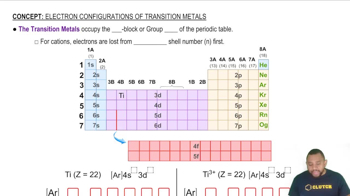Here are the essential concepts you must grasp in order to answer the question correctly.
Activity Series
The activity series is a list of metals ranked by their reactivity from highest to lowest. It helps predict whether a metal will displace another in a chemical reaction. More reactive metals can replace less reactive ones in compounds, which is crucial for understanding single displacement reactions.
Recommended video:
Single Displacement Reactions
Single displacement reactions occur when one element replaces another in a compound. The general form is A + BC → AC + B, where A is a more reactive element displacing B from the compound BC. Understanding this type of reaction is essential for applying the activity series to predict reaction outcomes.
Recommended video:
Single Displacement Reactions
Reactivity of Metals
The reactivity of metals is influenced by their ability to lose electrons and form positive ions. Factors such as atomic size, ionization energy, and electronegativity play a role in determining a metal's reactivity. This concept is vital for interpreting the activity series and predicting which reactions will occur.
Recommended video:
 Verified step by step guidance
Verified step by step guidance


